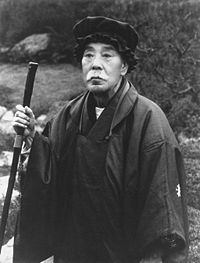- Miura Gorō
-
Viscount Miura Gorō
General Miura GorōBorn January 1, 1847
Hagi, Chōshū Domain, JapanDied January 28, 1926 (aged 79)
Tokyo, JapanAllegiance Empire of Japan Service/branch  Imperial Japanese Army
Imperial Japanese ArmyRank Lieutenant General Battles/wars Boshin War
Satsuma RebellionOther work Privy Council In this Japanese name, the family name is "Miura".Viscount Miura Gorō (三浦 梧楼, 1 January 1847 – 28 January 1926), was a lieutenant general in the early Imperial Japanese Army.
Biography
Miura was born in Chōshū Domain (modern Yamaguchi Prefecture), to a samurai of the Hagi clan. After studying at the Meirinkan clan military academy, he entered the Kiheitai irregular militia of the Chōshū domain and played an active role in the Boshin War to overthrow the Tokugawa bakufu. He later held various posts in Army-Navy Ministry and was commander of the Hiroshima District. During the Satsuma Rebellion, he served as commander of the Army's Third Brigade.
In 1884, he accompanied Ōyama Iwao on a tour of Europe, to study the military systems in various western countries. In 1888, after coming into conflict with politicians in the Chōshū clan clique, he was transferred from active duty to the reserves. In November of the same year, he retired and became president of Gakushuin Peers’ School.
In 1890, Miura was appointed a member of the House of Peers, and elevated in title to shishaku (viscount) under the kazoku peerage system.
In 1895, Miura was appointed Japan’s resident minister in Korea, succeeding Inoue Kaoru. Later that year, the political situation in Korea became increasingly unsettled due to the international outrage over the assassination of Korean Empress Myeongseong. Miura played the critical role in the assassination and was recalled to Japan and placed on a farcical trial with the involved military personnel at the Hiroshima District Court. The trial was held for political purposes to give an impression of rule of law to western nations. Miura's attorney argued in defense that killing is no murder when done to achieve political supremacy with Miura even admitting to the assassination. Nonetheless, the court found him not guilty on technical grounds of insufficient evidence[1] and Miura and cohorts emerged from trial as national heroes.
Later, after the Japan-Korea Annexation Treaty in 1910, Miura became a privy councilor and focused on mediating talks among the heads of the political parties to protect the Meiji Constitution.
References
- ^ Chung, Henry (1921). The Case of Korea: A collection of evidence on the Japanese domination of Korea, and on the development of the Korean Independence Movement. New York, Chicago, London and Edingurgh: Fleming H. Revell Company. p. 327. ISBN 978-1104579128. http://books.google.com/books?id=3x0pAAAAYAAJ&pg=PA2&dq=The+Case+of+Korea:+A+collection+of+evidence+on+the+Japanese+domination+of+Korea,+and+on+the+development+of+the+Korean+Independence+Movement&cd=1#v=snippet&q=miura&f=false. "Notwithstanding these facts, there is no sufficient evidence to prove that any of the accused actually committed the crime originally meditated by the,. Neither is there sufficient evidence to establish the charge that Hirayama Iwahiko killed Li Koshoku, the Korean Minister of the Household, in front of the Kon-Chong palace.
As to the accused, Shiba Shiro, Osaki Masakichi, Yoshida Hanji, Mayeda Shunzo, Hirayama Katsukuma, and Hiraishi Yoshitarom there is not sufficient evidence to show that they were in any way connected with the affair.
For these reasons the accused, each and all, are hereby discharged in accordance with the provisions of article 165 of the Code of Criminal Procedure. The accused, Miura Goro, Sugimura Fukashi, Okamoto Ryunosuke, Adachi Kenzo, Kunimoto Shigeakira, Terasaki Taikichi, Hirayama Iwabiko, Nakamura Takewo, Fuji Masahira, Iyuri Kakichi, Kiwaki Sukenori, and Sokoi Masutaro, are hereby released from confinement. The documents and other articles seized in connection with this case are restored to their respective owners.
Given at Hiroshima Local Court by Yoshida Yoshihide, Judge of Preliminary Enquiry; Tamura Yoshiharu, Clerk of the Court."
External links
- National Diet Library. "Miura, Goro". Portraits of Modern Japanese Historical Figures. http://www.ndl.go.jp/portrait/e/datas/196.html.
Categories:- 1846 births
- 1926 deaths
- Kazoku
- People of the Boshin War
- People from Yamaguchi Prefecture
- Japanese generals
- 1895 crimes
- People in Meiji period Japan
- Japanese assassins
- Members of the House of Peers (Japan)
- ^ Chung, Henry (1921). The Case of Korea: A collection of evidence on the Japanese domination of Korea, and on the development of the Korean Independence Movement. New York, Chicago, London and Edingurgh: Fleming H. Revell Company. p. 327. ISBN 978-1104579128. http://books.google.com/books?id=3x0pAAAAYAAJ&pg=PA2&dq=The+Case+of+Korea:+A+collection+of+evidence+on+the+Japanese+domination+of+Korea,+and+on+the+development+of+the+Korean+Independence+Movement&cd=1#v=snippet&q=miura&f=false. "Notwithstanding these facts, there is no sufficient evidence to prove that any of the accused actually committed the crime originally meditated by the,. Neither is there sufficient evidence to establish the charge that Hirayama Iwahiko killed Li Koshoku, the Korean Minister of the Household, in front of the Kon-Chong palace.
Wikimedia Foundation. 2010.

